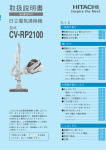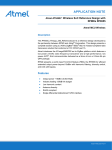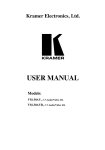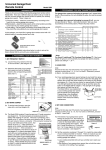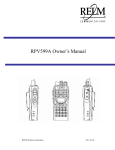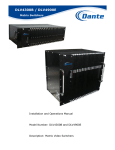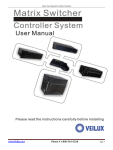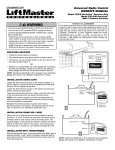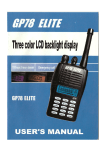Download RP3000 user manual V1.0 - RELM Wireless Corporation
Transcript
RELM Wireless Corporation 1 THANK YOU Thank you for your purchase of the RELM two-way portable radio. This easy-to-use radio adopts the latest advanced technology, providing reliable communication performance in today’s demanding communications environment. Before operating this radio, please read this manual carefully to be acquainted with its operation and features. 2 Contents User Safety, Training, and General Information Compliance with RF Energy Exposure Standards FCC Compliance Precautions Supplied Accessories Battery Information Accessory Installation Getting Started Features and Operation Turn on/off the radio Adjust the Volume Select Channel Transmit Receive Monitor Repeater/Talk Around Repeater/ Reverse Frequency Selectable Power Scan Call Selective Call Emergency ANI/Emergency Siren VOX Feature Built-in Modem Patrol Record Low Battery Alert Care and Cleaning Service 3 User Safety, Training, and General Information READ THIS IMPORTANT INFORMATION ON SAFE AND EFFICIENT OPERATION BEFORE USING YOUR RELM PORTABLE TWO-WAY RADIO. Compliance with RF Energy Exposure Standards Your RELM two-way radio is designed and tested to comply with a number of national and international standards and guidelines (listed below) regarding human exposure to radio frequency electromagnetic energy. This radio complies with the IEEE (FCC) and ICNIRP exposure limits for occupational/controlled RF exposure environment at duty cycles of up to 50% talk-50% listen and should be used for occupational use only. In terms of measuring RF energy for compliance with the FCC exposure guidelines, your radio radiates measurable RF energy only while it is transmitting (during talking), not when it is receiving (listening) or in standby mode. Note: The approved batteries supplied with this radio are rated for a 5-5-90 duty cycle (5% talk-5% listen-90% standby), even though this radio complies with the FCC occupational RF exposure limits at duty cycles of up to 50% talk. Your RELM two-way radio complies with the following of RF energy exposure standards and guidelines: l United States Federal Communications Commission, Code of Federal Regulations; 47CFR part 2 sub-part J l American National Standards Institute (ANSI)/Institute of Electrical and Electronic Engineers (IEEE) C95. 1-1992 l Institute of Electrical and Electronic Engineers (IEEE) C95. 1-1999 Edition l I?nternational Commission on Non-Ionizing Radiation Protection (ICNIRP) 1998 l Ministry of Health (Canada) Safety Code 6. Limits of Human Exposure to Radio Frequency Electromagnetic Fields in the Frequency Range from 3KHz to 300GHz, 1999 l Australian Communications Authority Radio communications (Electromagnetic Radiation-Human Exposure) Standard 1999 (applicable to wireless phones only) Operational Instructions and Training Guidelines To ensure optimal performance and compliance with the occupational/controlled environment RF energy exposure limits in the above standards and guidelines, users should transmit no more than 50% of the time and always adhere to the following procedures: Transmit and Receive To transmit (talk), push the Push-To-Talk (PTT) button; to receive, release the PTT button. Hand-held radio operation Hold the radio in a vertical position with the microphone one to two inches (2.5 to 5 cm) away from the lips. Body-worn operation l Always place the radio in a RELM approved clip, holder, holster, case, or body harness for this product. Use of non-RELM-approved accessories may exceed 4 FCC RF exposure guidelines. l If you do not use a RELM approved body-worn accessory and are not using the radio in the intended use position in front of the face, then ensure the antenna and the radio are kept one inch (2.5 cm) from the body when transmitting. Antennas & Batteries l Use only RELM approved, supplied antenna or RELM approved replacement antenna. Unauthorized antennas, modifications, or attachments could damage the radio and may violate FCC regulations. l Use only RELM approved, supplied batteries or RELM approved replacement batteries. Use of non-RELM-approved batteries may exceed FCC RF exposure guidelines. Approved Accessories For a list of RELM approved accessories, see the accessories page of this user manual or visit the following website which lists approved accessories: http://www.RELM.com FCC Compliance This equipment has been tested and found to comply with the limits for a Class B digital device, pursuant to part 15 of the FCC Rules. These limits are designed to provide reasonable protection against harmful interference in a residential installation. This equipment generates, uses and can radiate radio frequency energy and, if not installed and used in accordance with the instructions, may cause harmful interference to radio communications. However, there is no guarantee that interference will not occur in a particular installation. If this equipment does cause harmful interference to radio or television reception, which can be determined by turning the equipment off and on, the user is encouraged to try to correct the interference by one or more of the following measures: ? Reorient or relocate the receiving antenna. ? Increase the separation between the equipment and receiver. ? Connect the equipment into an outlet on a circuit different from that to which the receiver is connected. ? Consult the dealer or an experienced radio/TV technician for help. Industry Canada Compliance This Class B digital apparatus complies with Canadian ICES-003. Cet appareil numerique de la classe B est conforme à la norme NMB-003 Canada. FCC Requirements Your radio must be properly licensed Federal Communications Commission prior to use. Your RELM Wireless dealer can assist you in meeting these requirements. Your dealer will program each radio with your authorized frequencies, signaling codes, etc., and will be there to meet your communications needs as your system expands. Precautions • • Only qualified technicians are allowed to maintain this product. Do not use the transceiver or charge a battery in explosive areas such as coal gas, 5 dust, steam, etc. • • • Switch OFF the transceiver while refueling or parking at gas station. Do not modify or adjust this transceiver without permission. Do not expose the transceiver to direct sunlight over a long time, nor place it close to heating source. • Do not place the transceiver in excessively dusty, humid areas, nor on unstable surfaces. Safety: It is important that the operator is aware of and understands hazards common to the operation of any transceiver. 6 Supplied Accessories Please carefully take the transceiver out of the box. We recommend that you confirm the items listed in the following table before discarding the box. If any items are missing or have been damaged during shipment, file a claim with the carrier immediately. Item Qty. (pcs) Antenna * 1 Belt Clip 1 Strap 1 Battery 1 Desktop Charger 1 AC Adapter 1 Declaration of Conformity 1 Owner’s Manual 1 * RP3000 Antenna Mark: 400-430MHz: Dark red 440-470MHz: Milk White 130-150MHz: Sky Blue 145-175MHz: Grass Green 350-370MHz: Saffron 370-390MHz: Background Color Battery Information Battery Charging Information The battery is not charged by the manufactory. Charge the newly purchased battery or out of use for more than 2 months battery before use. The battery capacity will be optimum only after being charged/discharged for two or three times. When the battery power is lower, please charge it or replace it with a new one. Notices: ? Do not short out the battery terminals or dispose of the battery by fire. ? Turn off the radio when charging the battery inside the radio. ? Remove the radio and the battery from the charger when charging cycle is over. Overcharging will shorten the battery life. ? Do not continue charging the battery if it is already fully charged. Or the battery life will be shortened. ? Store the battery in a place about 25? . Charging the battery in less than 10? temperature will cause the electrolyte leakage and damage the battery. ? Charging the battery in over 35? temperature will affect the battery capacity. 7 Charging the Battery You are recommended to use HYT authorized charger. Charger LED will indicate the charging status. LED Meaning Red LED flashes Power voltage too low Charging Done Red LED glows Green LED glows Accessory Installation Battery Attach the battery Insert the two tabs on bottom of the battery into the slots at the bottom of the radio. Push top of the battery towards the radio until a click is heard. (See figure 1) Fig.1 Slot Remove the battery Turn off the radio. Push the battery latch on the middle of the radio to remove the upper side of the battery away from the radio. And then remove the battery. (See figure2) Battery Latch Fig.2 8 Antenna Insert the threaded end of the antenna into the connector on top of the radio. Rotate the antenna clockwise to fasten it. Rotate the antenna counterclockwise to remove it. (See the following figure) Install Remove Belt Clip Attach Belt Clip Align the slot of the belt clip with the T-slot at the battery cover and press the belt clip downwards until it is locked. (See figure 3) Fig.3 Remove the belt clip Press the disassembly release upwards with a key until it releases and then push the belt clip upwards with your thumb to remove it. (See figure 4) 9 ? Disassembly ? ? Release Fig.4 Earplug Cover Rotate the screw at the bottom of the cover counter clockwise by a screwdriver until it is out of the nut to remove the Earphone/Microphone jack cover. (See figure 5) Fig.5 External Earphone/Microphone (Optional) Insert the tab at the bottom of the earphone/microphone into the slot on top of the radio. (See figure 6). Align the nuts at top of the earphone/microphone with the holes on the radio and then turn them clockwise to fasten. Fig.6 10 Getting Started (1) Antenna Used to transmit/receive signals. (2) LED Following table indicates LED indication and corresponding radio status. LED No display Status Standby Green Receive Red Transmit Flashing green Scan Flashing red Low battery voltage Flashing orange Call waiting (3) Channel Selector Used to select wanted channel. (4) Programmable key [A] (5) Power/Volume Control Knob Rotate the Power/Volume Knob clockwise until a “click” is heard to turn the radio on, fully counter clockwise to turn the radio off. When the radio is on, turn the knob to adjust volume. (6) Battery Latch Used to fasten the battery. (7) Speaker Used to output sounds. (8) Microphone Used to input sounds. (9) External Jack 11 Used to connect with external earphone or programming cable. (10) Belt Clip Used to clip the radio on your belt. (11) Battery Pack (12) PTT key Press and hold PTT, radio operates in transmit mode. Release PTT, radio returns to receive mode. (13) Programmable Key [B] (14) Programmable Key [C] The following table shows the key function when 1. Briefly press; 2. Press and hold (more than one second); 3. Hold down and monitor. Key function Key Function Briefly Press Press and Hold Hold Down Emergency Siren Enable emergency siren Disable emergency siren - Monitor - - Monitor Enable/Disable scan Enable/Disable scan - Scan Nuisance Delete Delete nuisance channel Delete nuisance channel in in scan scan - Select High/Low Power Select High/Low Power - Repeater/Talk Around Repeater/Reverse Frequency Select High/Low Power Select Repeater or Talk Select Repeater or Talk Around Mode Around Mode Select Repeater or Select Repeater or Reverse Frequency Mode Reverse Frequency Mode - Call Transmit a Call Transmit a Call - Selective Call Transmit Selective Call Transmit Selective Call - Group Call Transmit Group Call Transmit Group Call - Vibration Toggle Vibration On/off Toggle Vibration On/off - Please contact your dealer for more details about programmable key. 12 Features and Operation Note: The radio provides a series of audible alert tones. A series of tones may be sounded with the following conditions: Alt Bourdon Operation Turn on the radio Turn on the radio Repeater/Talk Around Repeater/Talk Around Repeater/Reverse Frequency Repeater/Reverse Frequency Select Power Select Power Description Power on-Ready Power on-Failure Repeater Talk Around Repeater Audible Tone Reverse Frequency High Power Low Power Low Battery Alert Tone Idle Channel Tone PLL Unlock Tone Turn On/Off the Radio Rotate “Power/Volume” knob clockwise. An alert tone indicates that the self-test of the radio has been completed satisfactorily. LED glows green at the same time. If self-test fails and/or the selected channel is not set, you will also hear an alert tone. Rotate “Power/Volume” knob counterclockwise until a click is heard to turn the radio off. Adjust the Volume Rotate “Power/Volume” knob to adjust the volume. Select Channel The radio provides 16 conventional channels. Some of the channels may be not programmed and can’t be used. Please contact your dealer for more details. Rotate “Channel Selector” knob to select wanted channel. Transmit 1. Turn on the radio. 2. Rotate “Channel Selector” knob to select wanted channel. 3. Press PTT and speak into the microphone with your mouth 2.5-5 centimeters away from the radio. LED glows red during transmission. 4. Release PTT key to finish speaking. Receive 1. Turn on the radio. 2. Rotate “Channel Selector” knob to select wanted channel. 3. Adjust the volume. 4. Then you can receive a valid call. LED glows green during receiving. 13 5. If press Vibration key to toggle vibration on, the radio will alert you with vibration without opening the speaker when receiving a call. 6. If CTCSS/CDCSS or squelch tail elimination feature is set by your dealer: 1) Noise will be removed at the end of a conversation if roger tone is disabled. 2) Beep tone sounds at the end of a conversation if roger tone is enabled; Please contact your dealer for more details. Monitor 1. Press MONI key to monitor the current channel. 2. Release MONI key to exit. Repeater/Talk Around When the repeater doesn’t work or you are out of the communication range of the repeater and within the communication range of your group member, you can bypass the repeater and talk directly to your group member. Press programmed “Repeater/Talk Around” key to select between repeater and talk around mode. An alert tone indicates that radio operates in talk around mode. A different alert tone indicates that you are talking via a repeater. Repeater/Reverse Frequency When you are out of the communication range of the repeater and within the communication range of your group member, you can talk with your group member by reverse frequency if your group member is within the communication range of the repeater. Press programmed “Repeater/Reverse Frequency” key to select between repeater and reverse frequency. An alert tone indicates that radio operates in reverse frequency mode. A different alert tone indicates that you are talking via a repeater. Note: “Repeater/Talk Around” and “Repeater/Reverse Frequency” can’t be set simultaneously in one radio. Selectable Power Each channel of the radio is set as different power levels that are user selectable. (High power is forbidden in certain channels). 1. High power allows your talk to be heard from further distance. 2. Low power helps to save battery power. Press programmed “power select” key to select high/low power. An alert tone indicates that the radio operates at high power and another alert tone indicates low power. Scan Scan feature allows you to monitor all channels. When scan feature is enabled, the radio will detect all channels. If an active channel is detected, the radio will remain on that channel and you will be able to hear the conversation. Disable/Enable Scan Feature 1. Press scan key, scanning begins. 2. Press scan key again, scanning ends. LED flashes green in scan mode. Callback Pressing PTT during scanning can callback on the callback channel. Please contact 14 your dealer for more details about callback channel. Nuisance Delete Nuisance delete feature allows you to temporarily delete an unwanted channel from the scan list. When the radio stops on the nuisance channel, press the programmed “nuisance delete” key until an alert tone is sounded to delete this channel. When scan feature is enabled again. The deleted channel will return to the scan list. Note: Priority channel can’t be deleted. Priority Channel Scan This feature allows you to scan important channels. The dealer can program a channel as priority channel through the programming software. Please contact your dealer for more details. Channel Scan: Ch1àCh2àCh3àCh4à…Ch1 Priority Channel Scan ( Ch2 is priority channel ) : Ch2àCh1àCh2àCh3àCh2àCh4àCh2à…Ch1 Note: The radio will constantly monitor the priority channel when it stops on a non-priority channel. If an activity is detected on the priority channel, the radio will move to and remain on the priority channel. Call Press the programmed call key, the radio will sound a series of rings to call and wake the radio that has the same channel and signaling to draw the user’s attention. Selective Call The radio can call selected radios if selective call feature is set. Selective call signaling includes two-tone signaling and five-tone signaling. Transmit 1. Hold down PTT key and then press the programmable key [B], or press the programmed selective call key, the radio will transmit a series of programmed selective call signaling code. 2. If five-tone is enabled, hold down PTT and then press programmable key [C], or press the programmed group call key, the radio will transmit a series of programmed group call signaling code. 3. When transmission ends, the radio enters call waiting mode. When the called radio receives the signaling, it will send a confirmation tone to your radio. (If confirmation tone is not set on the called radio, no confirmation tone is returned to the caller.) 4. Then press PTT to talk. 5. When the call waiting reset time elapses, MONI key is pressed or channel selector knob is rotated, the radio will exit from the call waiting mode. Receive 1. When your radio receives a selective call signaling code or group call signaling code that is the same as your preset one, it will send a confirmation tone or vibrate (It is set by your dealer.) 2. After the confirmation tone transmission or the vibration, the radio enters call waiting mode. 3. Then pressing PTT can talk. 15 4. When the call waiting reset time elapses, MONI key is pressed or channel selector knob is rotated, the radio will exit from the call waiting mode. Note: LED flashes orange in call waiting mode. Emergency ANI/Emergency Siren The radio can be programmed to transmit emergency ANI. ANI can be DTMF or five-tone (It’s set by your dealer). After emergency ANI is transmitted, the radio will sound continuously at highest volume if emergency siren is enabled. 1. Press Emergency Siren key to transmit emergency ANI or enable Emergency Siren feature. 2. Press and hold Emergency Siren key to disable Emergency Siren feature. VOX Feature Plug an earphone with VOX feature into the radio to enable VOX feature. 1. VOX feature enables you to transmit automatically by speaking into the microphone. 2. Transmission stops automatically when you stop speaking. 3. Press PTT to disable VOX feature. 4. Turn the radio on again, VOX feature will be activated. Built-in Modem MSK modulator with speed of 1200/2400bit/s inside the radio supports data transmission. Please contact your dealer for details. Patrol Record An accessory is added to the radio to automatically record the identity, place, time and times of beat officer such as watchman. Please contact your dealer for details. Low Battery Alert When the battery voltage becomes low, the red LED will flash and beeps sound. You need to replace or recharge the battery. Care and Cleaning • Avoid physical abuse of your radio such as carrying it by the antenna or remote microphone. • Wipe the battery contacts with a lint-free cloth to remove dirt, grease, or other material that may prevent good electrical contact. • • When not in use, keep the accessory jacks covered with the protective cap. The case, controls, and keypad can be cleaned with a mild detergent and warm water. Avoid using strong chemicals. 16 Service If you need service, contact your RELM Communication, Inc. dealer. If you find it inconvenient to have service performed by your local dealer, you may contact the factory below: RELM Communication, Inc. 7100 Technology Dr. W. Melbourne, FL 32904 Attn: Service Department (800) 422-6281 www.RELM.com 17



















